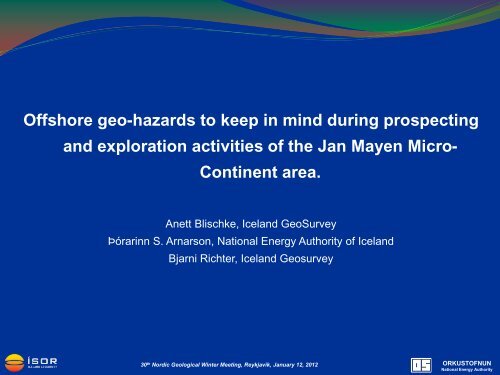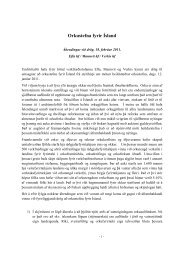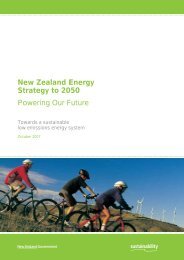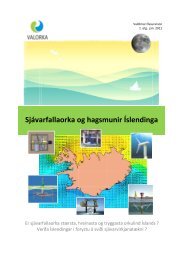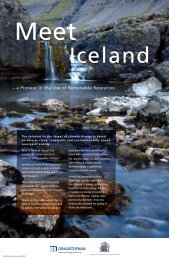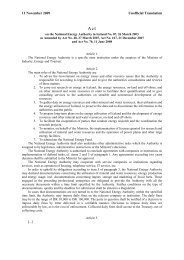Geohazards to be kept in mind during prospecting and exploration ...
Geohazards to be kept in mind during prospecting and exploration ...
Geohazards to be kept in mind during prospecting and exploration ...
You also want an ePaper? Increase the reach of your titles
YUMPU automatically turns print PDFs into web optimized ePapers that Google loves.
Offshore geo-hazards <strong>to</strong> keep <strong>in</strong> m<strong>in</strong>d dur<strong>in</strong>g prospect<strong>in</strong>g<br />
<strong>and</strong> <strong>exploration</strong> activities of the Jan Mayen Micro-<br />
Cont<strong>in</strong>ent area.<br />
Anett Blischke, Icel<strong>and</strong> GeoSurvey<br />
Þórar<strong>in</strong>n S. Arnarson, National Energy Authority of Icel<strong>and</strong><br />
Bjarni Richter, Icel<strong>and</strong> Geosurvey<br />
30 th Nordic Geological W<strong>in</strong>ter Meet<strong>in</strong>g, Reykjavík, January 12, 2012<br />
ORKUSTOFNUN<br />
National Energy Authority
Hydrocarbon <strong>exploration</strong> <strong>in</strong> deep water, offshore environmental<br />
considerations <strong>and</strong> geo-hazards<br />
‣ Environmental parameters<br />
• Reservoir depth (drill<strong>in</strong>g depth, drill path & position)<br />
• Water depth<br />
• Sea currents, weather & wave heights<br />
• Sea & surface temperature<br />
• Sea ice<br />
• Distance <strong>to</strong> shore<br />
• Wild life<br />
‣ Deep water geo-hazards<br />
• Complex & unstable sea <strong>be</strong>ds<br />
• Active & chang<strong>in</strong>g foundations<br />
• Shallow geo-pressure<br />
• Drill<strong>in</strong>g hazards<br />
• Deep sea environmental issues<br />
‣ Known hazards <strong>in</strong> O&G drill<strong>in</strong>g <strong>and</strong> production operations process<br />
‣ Know<strong>in</strong>g preventive measures <strong>be</strong>foreh<strong>and</strong> – cont<strong>in</strong>gency plann<strong>in</strong>g<br />
• Def<strong>in</strong>e possible environmental, geo- or technical hazards<br />
• Risk assessment <strong>and</strong> mitigation is essential<br />
• Detailed cont<strong>in</strong>gency plann<strong>in</strong>g<br />
30 th Nordic Geological W<strong>in</strong>ter Meet<strong>in</strong>g, Reykjavík, January 12, 2012<br />
ORKUSTOFNUN<br />
National Energy Authority
Environmental impact parameters comparison<br />
Jan Egil Arne<strong>be</strong>rg, BayernGas, Norge, Icel<strong>and</strong> Exploration Conference, 2008<br />
30 th Nordic Geological W<strong>in</strong>ter Meet<strong>in</strong>g, Reykjavík, January 12, 2012<br />
ORKUSTOFNUN<br />
National Energy Authority
Environment impact parameters<br />
Ma<strong>in</strong> conclusions from the SEA (Strategic Environment Assessment)<br />
‣ Water depths 1000m <strong>to</strong> 2000 m <strong>in</strong> 80% of the area<br />
‣ Great variability <strong>in</strong> biomass <strong>and</strong> consequently <strong>in</strong> habitats<br />
‣ The area is important feed<strong>in</strong>g ground for pelagic fish, especially herr<strong>in</strong>g,<br />
<strong>and</strong> possibly for whales<br />
‣ On-site current measurements needed (collected 2007-2008)<br />
‣ Need for registration <strong>and</strong> mapp<strong>in</strong>g of delicate habitats of <strong>be</strong>nthic<br />
species (started <strong>in</strong> 2008)<br />
‣ No <strong>in</strong>formation on demersal fish <strong>in</strong> the area (<strong>in</strong>vestigated <strong>in</strong> 2009)<br />
30 th Nordic Geological W<strong>in</strong>ter Meet<strong>in</strong>g, Reykjavík, January 12, 2012<br />
ORKUSTOFNUN<br />
National Energy Authority
Deep sea drill<strong>in</strong>g <strong>and</strong> operations example<br />
Gygrid offshore development example, FMC Technologies, Inc., Jan. 2011<br />
30 th Nordic Geological W<strong>in</strong>ter Meet<strong>in</strong>g, Reykjavík, January 12, 2012<br />
ORKUSTOFNUN<br />
National Energy Authority
Deep Water Geo-Hazards<br />
‣ Complex & unstable sea <strong>be</strong>ds<br />
• Soft, thick <strong>and</strong> high fluid content sediments<br />
at sea floor<br />
• Rugged, steep <strong>and</strong> slop<strong>in</strong>g <strong>to</strong>pography that<br />
can lead <strong>to</strong> failure with sediment flows <strong>and</strong><br />
turbidites<br />
• Rapid sedimentation <strong>and</strong> erosional<br />
processes<br />
‣ Active & chang<strong>in</strong>g foundations<br />
• Cont<strong>in</strong>uous <strong>and</strong> active fault<strong>in</strong>g can lead <strong>to</strong><br />
foundation <strong>in</strong>stability<br />
• Salt tec<strong>to</strong>nics <strong>and</strong> sea floor deformations<br />
• Steep fault scarps <strong>and</strong> extreme <strong>to</strong>pography<br />
‣ Shallow geo-pressure<br />
• Shallow water flows<br />
• Weakened sea <strong>be</strong>d <strong>and</strong> sub-sea <strong>be</strong>d<br />
foundation<br />
• Mud volcanoes, diapirs, fluid vents<br />
‣ Drill<strong>in</strong>g hazards<br />
• Shallow gas<br />
• Gas hydrates<br />
• Shallow water flow<br />
‣ Deep sea environmental issues<br />
• Deep sea currents<br />
• Oscillat<strong>in</strong>g deep sea currents<br />
Reference: modified after Kelv<strong>in</strong> Chow, Fugro, 2006<br />
30 th Nordic Geological W<strong>in</strong>ter Meet<strong>in</strong>g, Reykjavík, January 12, 2012<br />
ORKUSTOFNUN<br />
National Energy Authority
Possible Environmental <strong>and</strong> Geo-Hazards <strong>to</strong> consider<br />
Steve Wardlaw <strong>and</strong> Richard Salisbury, Fugro GeoConsult<strong>in</strong>g, Geophyics <strong>and</strong> <strong>Geohazards</strong> – Def<strong>in</strong><strong>in</strong>g Subsea<br />
Eng<strong>in</strong>eer<strong>in</strong>g Risk, March 2010<br />
30 th Nordic Geological W<strong>in</strong>ter Meet<strong>in</strong>g, Reykjavík, January 12, 2012<br />
ORKUSTOFNUN<br />
National Energy Authority
Deep Water Geo-Hazards – Applicability for the Jan Mayen Ridge<br />
‣ Complex & unstable sea <strong>be</strong>ds<br />
• Soft, thick <strong>and</strong> high fluid content sediments at sea floor<br />
• Rugged, steep <strong>and</strong> slop<strong>in</strong>g <strong>to</strong>pography that can lead <strong>to</strong> failure with<br />
sediment flows <strong>and</strong> turbidites<br />
• Rapid sedimentation <strong>and</strong> erosional processes – possible<br />
gravitational failure on steep slopes of the JMR<br />
‣ Active & chang<strong>in</strong>g foundations<br />
• Cont<strong>in</strong>uous <strong>and</strong> active fault<strong>in</strong>g can lead <strong>to</strong> foundation <strong>in</strong>stability<br />
• Salt tec<strong>to</strong>nics <strong>and</strong> sea floor deformations<br />
• Steep fault scarps <strong>and</strong> extreme <strong>to</strong>pography<br />
• Earth quakes<br />
Reference: modified after<br />
Kelv<strong>in</strong> Chow, Fugro, 2006<br />
30 th Nordic Geological W<strong>in</strong>ter Meet<strong>in</strong>g, Reykjavík, January 12, 2012<br />
ORKUSTOFNUN<br />
National Energy Authority
Elevation Dip<br />
50°<br />
M<strong>in</strong>d<strong>in</strong>g Topography<br />
Multi-<strong>be</strong>am Survey 2008<br />
Mar<strong>in</strong>e Research Institute & NEA<br />
5°<br />
Possibly polygonal fault pattern related <strong>to</strong> dewater<strong>in</strong>g<br />
of clay rich soft sediments.<br />
30 th Nordic Geological W<strong>in</strong>ter Meet<strong>in</strong>g, Reykjavík, January 12, 2012<br />
ORKUSTOFNUN<br />
National Energy Authority
M<strong>in</strong>d<strong>in</strong>g Topography<br />
Multi-<strong>be</strong>am Survey 2008<br />
Mar<strong>in</strong>e Research Institute & NEA<br />
Sediment slide example<br />
30 th Nordic Geological W<strong>in</strong>ter Meet<strong>in</strong>g, Reykjavík, January 12, 2012<br />
ORKUSTOFNUN<br />
National Energy Authority
Elevation Dip<br />
50°<br />
M<strong>in</strong>d<strong>in</strong>g Topography<br />
5°<br />
Identify<strong>in</strong>g steep slope<br />
areas<br />
Modified Multi-<strong>be</strong>am Survey 2008<br />
Mar<strong>in</strong>e Research Institute & NEA<br />
30 th Nordic Geological W<strong>in</strong>ter Meet<strong>in</strong>g, Reykjavík, January 12, 2012<br />
ORKUSTOFNUN<br />
National Energy Authority
Deep Water Geo-Hazards – Applicability for the Jan Mayen Ridge<br />
‣ Shallow geo-pressure<br />
• Shallow water flows <br />
• Weakened sea <strong>be</strong>d <strong>and</strong> sub-sea <strong>be</strong>d<br />
foundation<br />
• Mud volcanoes , diapirs, fluid vents<br />
‣ Drill<strong>in</strong>g hazards<br />
• Shallow gas – possible<br />
• Gas hydrates – possible<br />
• Shallow water flow <br />
Reference: modified after<br />
Kelv<strong>in</strong> Chow, Fugro, 2006<br />
30 th Nordic Geological W<strong>in</strong>ter Meet<strong>in</strong>g, Reykjavík, January 12, 2012<br />
ORKUSTOFNUN<br />
National Energy Authority
TWT (ms)<br />
Possible <strong>in</strong>dications of Gas Hydrates: Bot<strong>to</strong>m Simulat<strong>in</strong>g Reflec<strong>to</strong>r<br />
(BSR) or diagenetic effects<br />
SSW<br />
NNE<br />
Data by courtesy of<br />
~500ms<br />
30 th Nordic Geological W<strong>in</strong>ter Meet<strong>in</strong>g, Reykjavík, January 12, 2012<br />
ORKUSTOFNUN<br />
National Energy Authority
Possible <strong>in</strong>dications of Gas<br />
Hydrates: Bot<strong>to</strong>m<br />
Simulat<strong>in</strong>g Reflec<strong>to</strong>r (BSR)<br />
or diagenetic effects<br />
Potential BSR mapped over the<br />
Dreki area of the JMMC<br />
30 th Nordic Geological W<strong>in</strong>ter Meet<strong>in</strong>g, Reykjavík, January 12, 2012<br />
ORKUSTOFNUN<br />
National Energy Authority
TWT<br />
(ms)<br />
▬<br />
Sea<strong>be</strong>d<br />
SSW<br />
Fluid vent example – Southeastern JMR<br />
900m<br />
Data by courtesy of<br />
NNE<br />
▬<br />
Pleis<strong>to</strong>cene - Pliocene<br />
▬<br />
UC Late Oligocene - Miocene<br />
▬<br />
UC Base Late Oligocene<br />
▬<br />
Top Eocene<br />
▬<br />
UC Middle Eocene<br />
▬<br />
UC Top Paleocene<br />
▬<br />
Eocene – Oligocene Intrusive<br />
30 th Nordic Geological W<strong>in</strong>ter Meet<strong>in</strong>g, Reykjavík, January 12, 2012<br />
ORKUSTOFNUN<br />
National Energy Authority
TWT (ms)<br />
Steep slopes <strong>and</strong> gravitational failure example - JMR<br />
SE<br />
3000m<br />
Data by courtesy of<br />
NW<br />
30 th Nordic Geological W<strong>in</strong>ter Meet<strong>in</strong>g, Reykjavík, January 12, 2012<br />
ORKUSTOFNUN<br />
National Energy Authority
‣ Deep sea environmental issues<br />
• Deep sea bot<strong>to</strong>m currents – weak flow<br />
• Oscillat<strong>in</strong>g deep sea currents –<br />
local seasonal variations<br />
Surface currents <strong>in</strong> the North-Atlantic<br />
• Measurements conducted by tak<strong>in</strong>g<br />
ADCP profiles from a ship <strong>and</strong> by an<br />
anchored moor<strong>in</strong>g<br />
• Weak flow of bot<strong>to</strong>m current velocity<br />
<strong>in</strong> the area on the order of 5 cm/s<br />
• Seasonal variation <strong>be</strong>tween upper<br />
current <strong>and</strong> bot<strong>to</strong>m flows<br />
Mar<strong>in</strong>e Research Institute, 2007<br />
30 th Nordic Geological W<strong>in</strong>ter Meet<strong>in</strong>g, Reykjavík, January 12, 2012<br />
ORKUSTOFNUN<br />
National Energy Authority
Kjell Arne Mork et al, 2011<br />
Curtesy of Ste<strong>in</strong>grimur Jónsson, University of Akureyri<br />
30 th Nordic Geological W<strong>in</strong>ter Meet<strong>in</strong>g, Reykjavík, January 12, 2012<br />
ORKUSTOFNUN<br />
National Energy Authority
Necessity <strong>to</strong> specify<strong>in</strong>g Risk – Risk Matrix Example<br />
Steve Wardlaw <strong>and</strong> Richard Salisbury, Fugro GeoConsult<strong>in</strong>g, Geophyics <strong>and</strong> <strong>Geohazards</strong> – Def<strong>in</strong><strong>in</strong>g Subsea<br />
Eng<strong>in</strong>eer<strong>in</strong>g Risk, March 2010<br />
30 th Nordic Geological W<strong>in</strong>ter Meet<strong>in</strong>g, Reykjavík, January 12, 2012<br />
ORKUSTOFNUN<br />
National Energy Authority
Summary<br />
‣ Need <strong>to</strong> <strong>be</strong> realistic: Accidents dur<strong>in</strong>g the offshore oil <strong>and</strong> gas development do<br />
happen - but they need <strong>to</strong> <strong>be</strong> avoided as far as plann<strong>in</strong>g, technology <strong>and</strong> operations<br />
are concerned.<br />
‣ Safety <strong>and</strong> environmental regulations have <strong>to</strong> <strong>be</strong> followed !<br />
‣ Not <strong>to</strong> follow short cuts due <strong>to</strong> time or f<strong>in</strong>ancial pressure – this has played a role <strong>in</strong><br />
the events lead<strong>in</strong>g up <strong>to</strong> most recorded <strong>in</strong>cidents of disaster <strong>and</strong> pollution.<br />
‣ Most typical causes of accidents <strong>in</strong>clude:<br />
• Equipment failure<br />
• Personnel mistakes<br />
• Extreme natural impacts (seismic activity, ice fields, hurricanes, etc.)<br />
‣ Ma<strong>in</strong> hazards are connected with:<br />
• Spills <strong>and</strong> blowouts of oil, condensate, gas, <strong>and</strong> other chemical substances<br />
• Environmental consequences can <strong>be</strong> severe near shore, <strong>in</strong> shallow waters or areas<br />
with slow water circulation.<br />
30 th Nordic Geological W<strong>in</strong>ter Meet<strong>in</strong>g, Reykjavík, January 12, 2012<br />
ORKUSTOFNUN<br />
National Energy Authority
Thank you very much for your attention !<br />
30 th Nordic Geological W<strong>in</strong>ter Meet<strong>in</strong>g, Reykjavík, January 12, 2012<br />
ORKUSTOFNUN<br />
National Energy Authority


